What is the difference between non-native and invasive?Non-native species are those that were introduced to an area but may not necessarily cause problems to the natural environment. Non-natives can adjust to a new environment and call it home, even though they would not naturally exist there. Invasive species can be native or non-native but cause damage or prolonged issues to the environment. More often, invasive species are non-native and are introduced to an environment where they are not naturally occurring. Park biologists and managers actively try to reduce the quantity of the invasive species in the environment, while non-threatening non-natives are left since they do not pose as much of a threat. Aquatic Invasive SpeciesAt Lake Roosevelt, managing aquatic invasive species is critical for the sustainability of the lake. Mutiple partners work together to achieve these goals, depending on the gravity and the species. In some cases, the goal is to prevent the introduction of a new invasive species, while others may be to reduce the quantity of invasive species that already exist at the lake. Group efforts, boat inspections, self-certification forms, and bounties are some of the means of achieving these goals. Primary Invasive Fish at Lake Roosevelt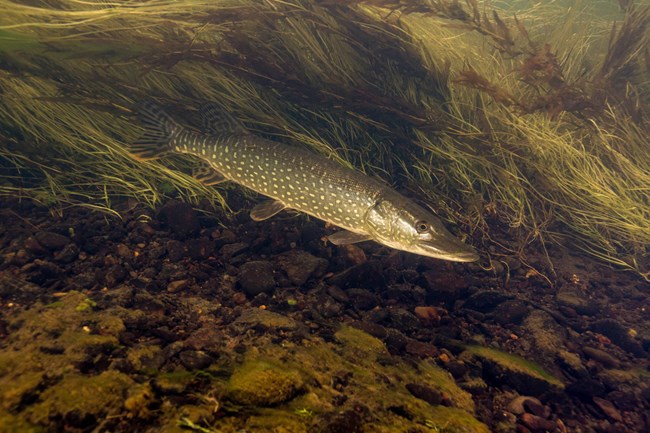
Ryan Hagerty/USFWS Northern PikeEsox lucius
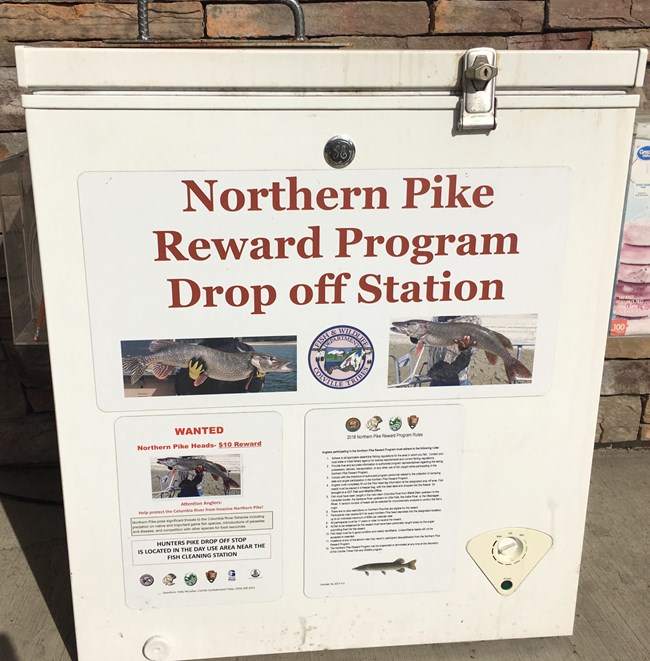
Credit Scott Leadingham Efforts to Reduce Northern PikeNorthern pike were originally introduced in this area on the Dry Fork Reservoir, in Montana in 1953. Since then, people have brought Northern pike to other areas of the Columbia Basin, including Lake Roosevelt. The Grand Coulee Dam helps to block Northern pike from accessing important salmon spawning habitat in the state of Washington; if they had access, they could cause further damage to salmon populations in Washington State. Northern pike are relatively new to Lake Roosevelt, however, that has not stopped managers from attempting to reduce their population as quickly as possible. The first documented northern pike at Lake Roosevelt was in 2010. Collaboration between the Colville Confederated Tribes, Spokane Tribe, and the Washington Department of Fish and Wildlife began in 2015. Their efforts have helped keep Northern pike numbers lower through specialized gill nets designed to capture Northern pike and let other fish bypass the net. Additionally, the Colville Confederated Tribes offers a bounty program for Northern pike: $10 per fish head turned in. 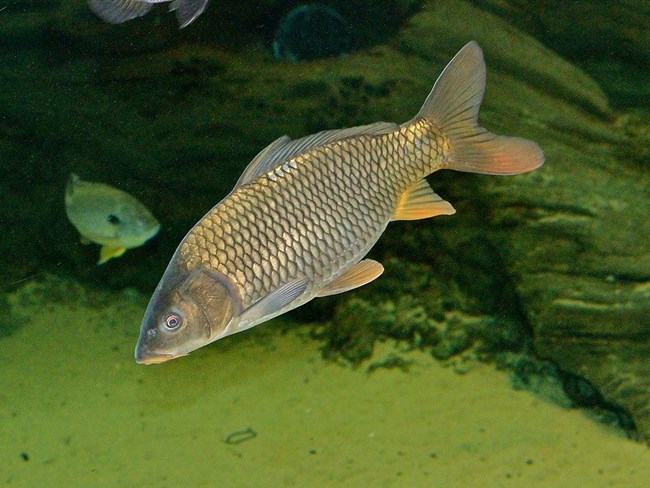
Credit Ron DeCloux Common CarpCyprinus carpio carpio
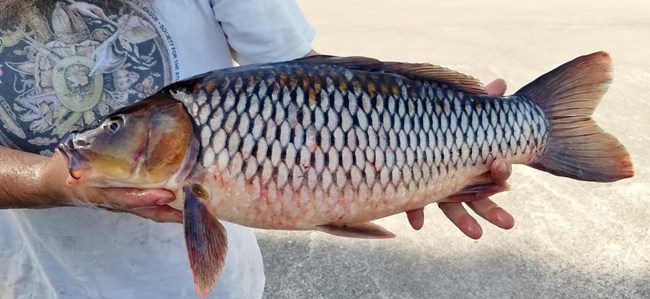
USGS/Kaitlin Kovacs Efforts to Reduce Common CarpSuccessfully reducing populations of invasive species requires a group effort. In the spring, the Colville Confederated Tribes Fisheries crew sets up large scale gill netting for common carp as a direct reduction of invasive species. On a smaller scale, the Washington Department of Fish and Wildlife does not require a fishing license to catch common carp, nor is there a limit on how many of them can be caught. While fishing at Lake Roosevelt, the National Park Service does require common carp to be caught on hook and line by anglers. These efforts will benefit the lake environment by reducing numbers of common carp over time, hopefully allowing for less destruction of aquatic vegetation and turbidity in the water. 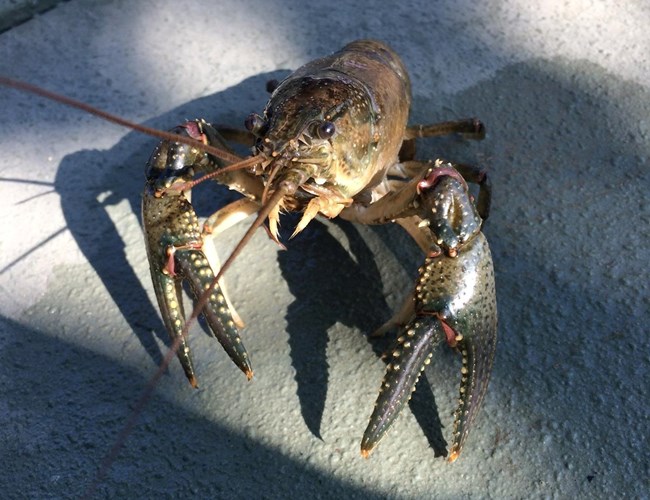
Patricia Thompson/USFWS Northern CrayfishFaxonius virilis While technically not fish, Northern crayfish (a crustacean) are listed as a fish according to Washington state regulations, which are adopted by Lake Roosevelt National Recreation Area.
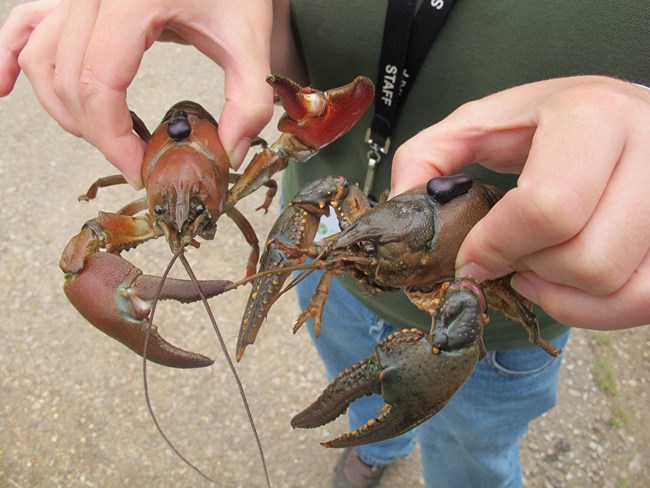
© Environment Agency 2011 Efforts to Reduce Northern CrayfishThe Northern crayfish is invasive along the Columbia Basin. Their presence affects the livelihood of the one native crayfish in this region: the signal crayfish. Being able to properly identify the differences is critical to the removal of invasive species. The signal crayfish (native) has smooth uniform brown color claws with white markings. Northern crayfish, on the contrary, have bumpy claws. Additionally, crayfish are often used as bait by anglers. One method of managing the spread of invasive crayfish is to ensure that anglers are knowledgeable about what types of crayfish are native vs non-native or invasive in an area. For this reason, educational programs are essential to ensure that anglers, students, and the public are familiar with various crayfish species. Crayfish fishing season is from the first Monday in May through October 31, throughout the state of Washington. Signal crayfish have fishing limits and more regulations, whereas the invasive and non-native crayfish species have different regulations. The latter must be kept in a separate container and be dead before being removed from the general area they were fished from. No license is required and there is no limit to the number of Northern crayfish caught in a day. Trained National Park Service staff are also involved in the removal of northern crayfish, using their expertise to identify them from the signal crayfish. |
Last updated: December 19, 2024
